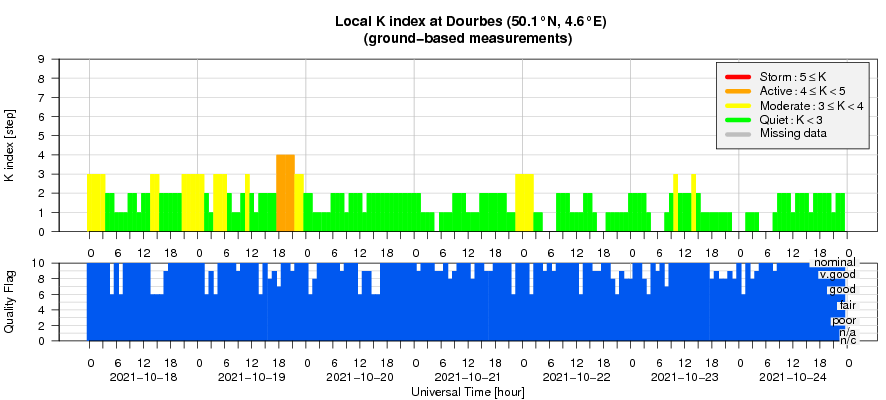- Table of Content
- 1.Tracking SC25
- 2.Job offer in i...
- 3.STCE at ESWW20...
- 4.Review of sola...
- 5.PROBA2 Observa...
- 6.The Internatio...
- 7.Review of geom...
- 8.Geomagnetic Ob...
- 9.The SIDC Space...
- 10.Review of iono...
- 11.Action!
2. Job offer in ionospheric research
3. STCE at ESWW2021
4. Review of solar activity
5. PROBA2 Observations (18 Oct 2021 - 24 Oct 2021)
6. The International Sunspot Number by Silso
7. Review of geomagnetic activity (18 Oct 2021 - 24 Oct 2021)
8. Geomagnetic Observations at Dourbes (18 Oct 2021 - 24 Oct 2021)
9. The SIDC Space Weather Briefing
10. Review of ionospheric activity (18 Oct 2021 - 24 Oct 2021)
11. Action!
Tracking SC25
The STCE released a new webpage called "SC25 Tracking" (https://www.stce.be/content/sc25-tracking ) with the aim to monitor the evolution of a number of parameters important in the space weather (SWx) domain, and this for the entire duration of the current solar cycle 25 (SC25). Is the sunspot number behaving as predicted? How many M- or X-class flares have been produced? Is that number smaller or larger than the previous solar cycles? How is the daily CME rate evolving? What are the effects on the geomagnetic indices such as the Ap- or Dst-index? This STCE webpage provides a first glimpse in answering such questions and allows a comparison with foregoing solar cycles. For each parameter, there is a graph with a few words of introduction often highlighting the importance for SWx, followed by an explanation of the graph and the status for SC25. The top of the page has a table allowing easy navigation to the parameters of interest. The current update rhythm is once every 4 months, so the next update is scheduled for February 2022. Enjoy!
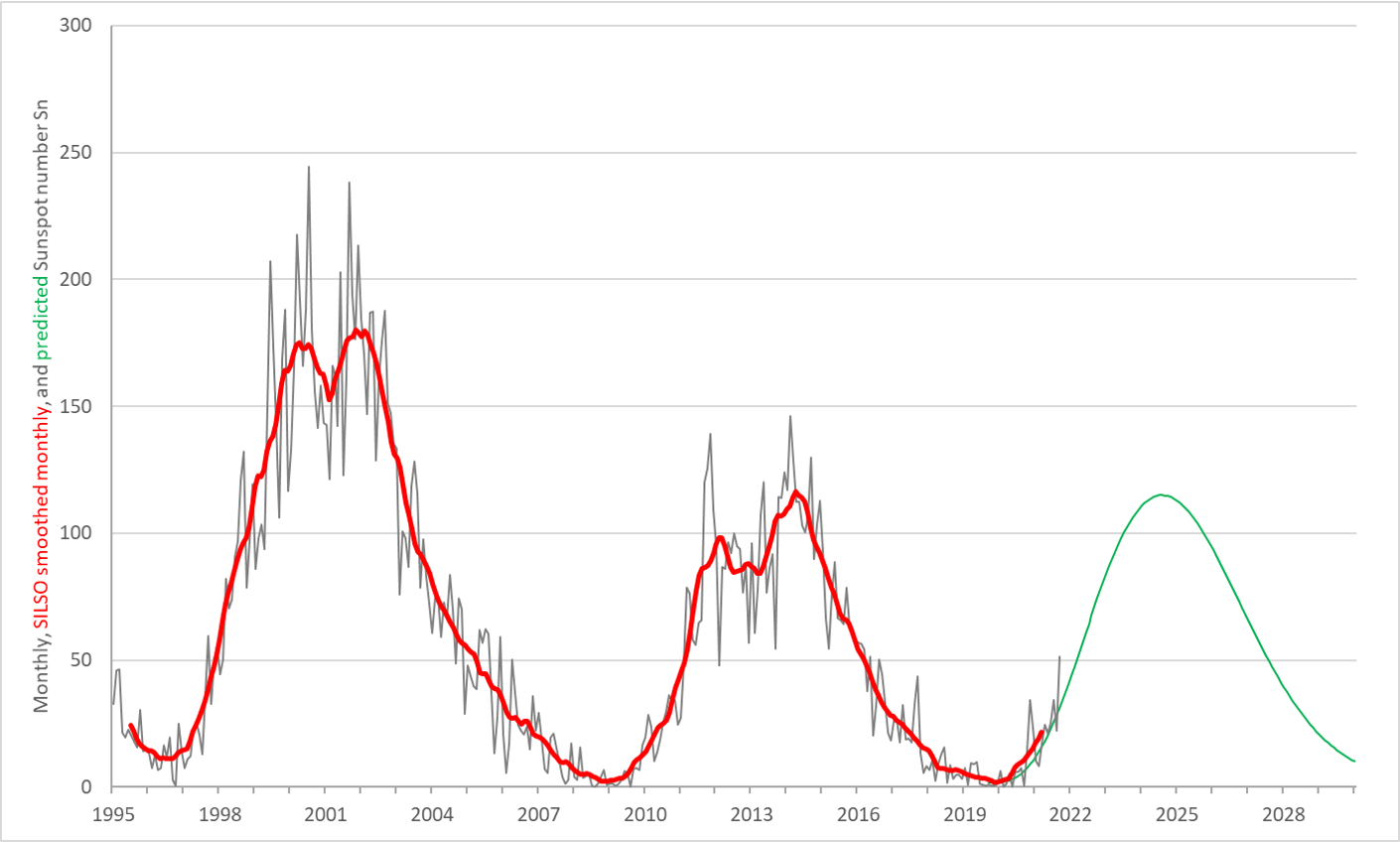
Job offer in ionospheric research
2-years post-doc position in (geo)physics and ionospheric research
The Operational Directorate “Reference Systems and Planetology” of the Royal Observatory of Belgium (ROB), and more specifically its section 'Time and Ionosphere', is looking for a post-doc specialized in data processing, data base and web development. The goal is to create new web tools to be used for Earth ionospheric research.

This scientific team is specialised in ionospheric monitoring and research. To complete its activity the candidate will use the home-made software to routinely monitor the ionospheric electron content in a global scale. During this 2-year postdoc, the candidate will adapt the software to process global GNSS data and develop a database from to relevant information can be extracted. The first aim of the work is to develop and create new web tools to be used for Earth ionospheric research. On a scientific point a view, the candidate will use these new tools to interpret the ionospheric variability during geophysical events such as earthquakes, tsunamis, hurricanes, and space weather episodes.
The candidate must have a PhD in physics/mathematics/geophysics/geography or equivalent and a good knowledge in data base and web development. Applications that include one or more of the following characteristics/qualities will be ranked as a priority:
* Skills in data base and web development, and data processing (programming languages such a bash, Perl, Fortran, python …).
* Strong research background or interest in earth science.
* A good knowledge of ionospheric research and GNSS data analysis is an asset.
* Proficiency in written and spoken English. Knowledge of French, Dutch or German is an added value.
The candidate is expected to be part of the Time and Ionosphere team of the ROB, to be able to work autonomously, as well as to participate to some operational activities. Strong communication skills and an open-minded personality are also expected.
How to apply:
* The candidate needs to send a cv and a motivation letter to nicolas.bergeot@oma.be
at the latest on November 30, 2021.
* The candidate needs to demonstrate past activity in the desired fields.
* The candidate must provide two recommendation letters.

STCE at ESWW2021
The Solar-Terrestrial Centre of Excellence (STCE) brings together Belgian sun-space-earth research, services and education.
Since 2017, the STCE and other European scientific institutes form PECASUS, a space weather service for civil aviation.
The STCE invests also strongly in education relying on a firm academic and service experience. Its Space Weather Education Centre offers tailored courses and trainings.
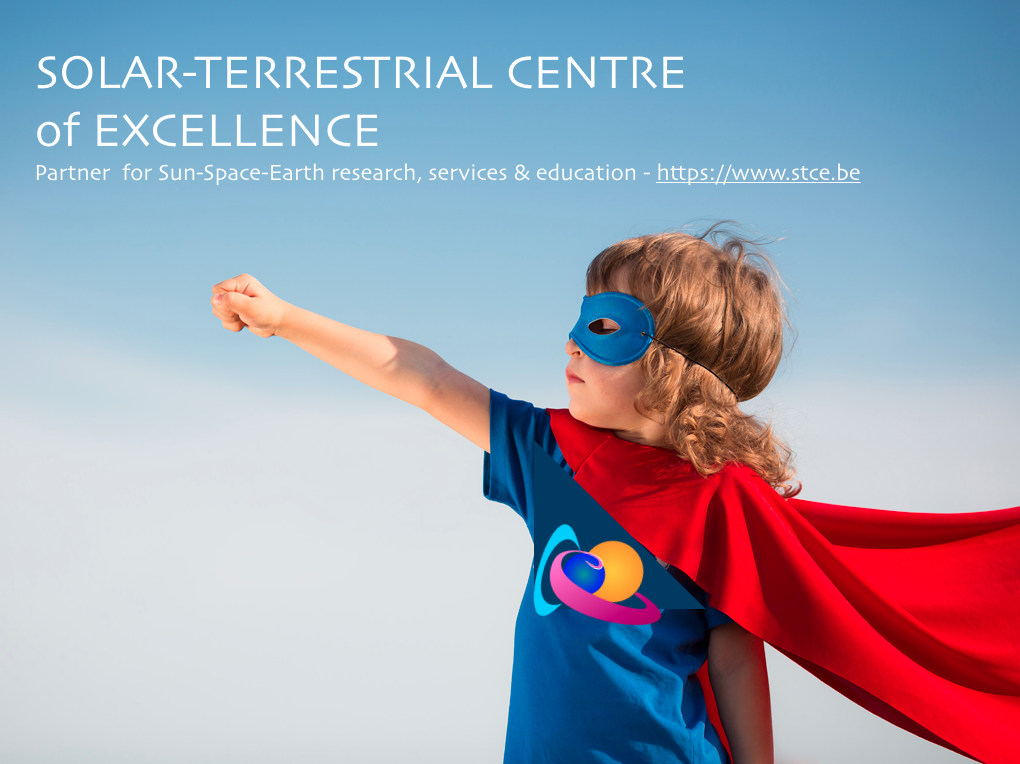
Check our movie shown in the virtual fair stand : https://www.youtube.com/watch?v=HMw7xw2BT8o
Review of solar activity
Solar activity was very low. Three Active Regions (AR) got a number in the course of the wee: NOAA AR 2886 on Oct 19, NOAA AR 2887 on Oct 23, NOAA AR 2888 on Oct 25. NOAA AR 2886 remained stable with an alpha configuration during the week. NOAA AR 2887, was responsible for most of the flares, producing a number of B-class flares. Two additional ARs rotated onto the disk on Oct 24, but got a number only on Oct 26.
No Earth directed Coronal Mass Ejections (CMEs) were detected in the available coronagraph imagery.
The greater than 10 MeV proton flux was at nominal levels.
The greater than 2 MeV electron flux remained below the 1000 pfu alert threshold and the 24h electron fluence was at nominal levels.
PROBA2 Observations (18 Oct 2021 - 24 Oct 2021)
Solar Activity
Solar flare activity was very low during the week.
In order to view the activity of this week in more detail, we suggest to go to the following website from which all the daily (normal and difference) movies can be accessed: https://proba2.oma.be/ssa
This page also lists the recorded flaring events.
A weekly overview movie can be found here (SWAP week 604). https://proba2.oma.be/swap/data/mpg/movies/weekly_movies/weekly_movie_2021_10_18.mp4
Details about some of this week's events can be found further below.
If any of the linked movies are unavailable they can be found in the P2SC movie repository here https://proba2.oma.be/swap/data/mpg/movies/
Thursday Oct 21
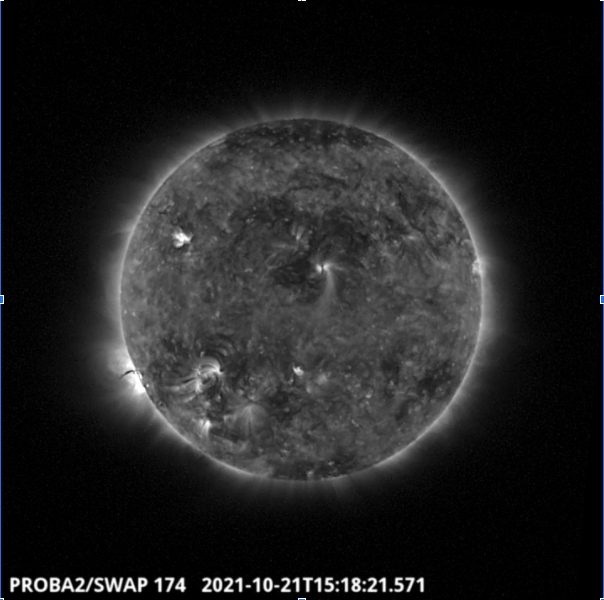
The largest flare of the week has been classified as a B8.7 flare. It originated from the NOAA active region labelled 2887. It is visible on the South East quadrant of the solar disk on the SWAP image above around 15:18 UT. Find a movie of the events here (SWAP movie) https://proba2.oma.be/swap/data/mpg/movies/20211021_swap_movie.mp4
The International Sunspot Number by Silso
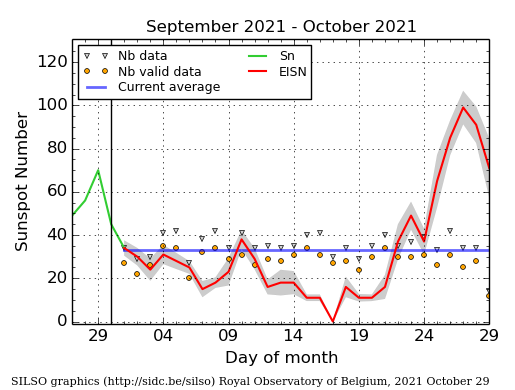
The daily Estimated International Sunspot Number (EISN, red curve with shaded error) derived by a simplified method from real-time data from the worldwide SILSO network. It extends the official Sunspot Number from the full processing of the preceding month (green line), a few days more than one solar rotation. The horizontal blue line shows the current monthly average. The yellow dots gives the number of stations that provided valid data. Valid data are used to calculate the EISN. The triangle gives the number of stations providing data. When a triangle and a yellow dot coincide, it means that all the data is used to calculate the EISN of that day.
Review of geomagnetic activity (18 Oct 2021 - 24 Oct 2021)
The solar wind was enhanced from Oct 17 to Oct 18. The Interplanetary Magnetic Field (IMF) reached a maximum value of 12 nT and a minimum Bz of -8 nT, as recorded by DSCVR.
A high speed stream arrived near Earth on Oct 21. It was associated with the extension of the negative southern polar CH which reached the central meridian on Oct 16. The solar wind speed reached maximum values of 560km/s on Oct 21.
By the end of the week, the solar wind was again in a slow regime.
Geomagnetic conditions reached active levels in the first half of the week (NOAA Kp and local K Dourbes 4) in response to the enhanced IMF and the extended period of negative Bz. From Oct 21, the conditions were quiet to unsettled.
The SIDC Space Weather Briefing
The Space Weather Briefing presented by the forecaster on duty from Oct 17 to 24. It reflects in images and graphs what is written in the Solar and Geomagnetic Activity report.

A pdf-version: https://www.stce.be/briefings/20211025_SWbriefing.pdf
The movie: https://www.stce.be/briefings/20211025_SWbriefing.m4v
Review of ionospheric activity (18 Oct 2021 - 24 Oct 2021)
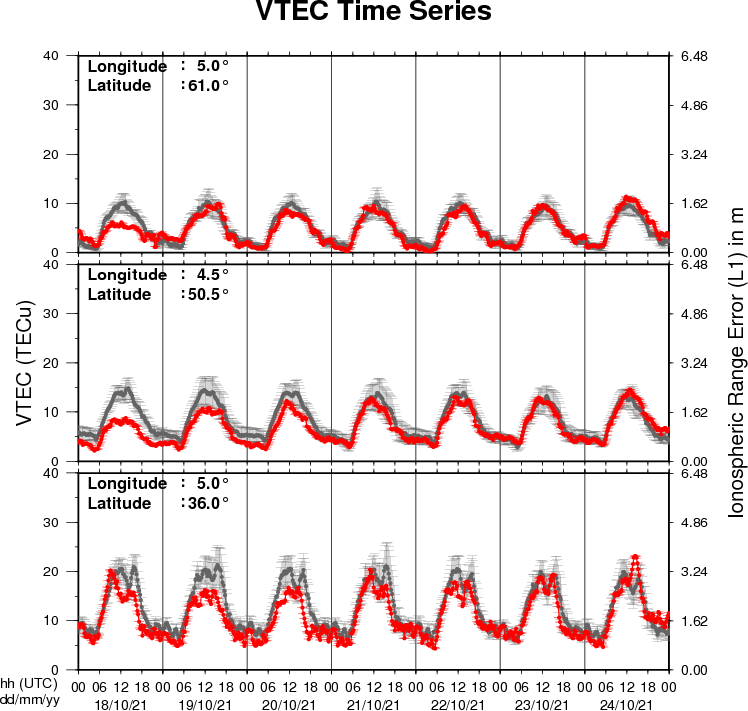
The figure shows the time evolution of the Vertical Total Electron Content (VTEC) (in red) during the last week at three locations:
a) in the northern part of Europe(N61°, 5°E)
b) above Brussels(N50.5°, 4.5°E)
c) in the southern part of Europe(N36°, 5°E)
This figure also shows (in grey) the normal ionospheric behaviour expected based on the median VTEC from the 15 previous days.
The VTEC is expressed in TECu (with TECu=10^16 electrons per square meter) and is directly related to the signal propagation delay due to the ionosphere (in figure: delay on GPS L1 frequency).
The Sun's radiation ionizes the Earth's upper atmosphere, the ionosphere, located from about 60km to 1000km above the Earth's surface.The ionization process in the ionosphere produces ions and free electrons. These electrons perturb the propagation of the GNSS (Global Navigation Satellite System) signals by inducing a so-called ionospheric delay.
See http://stce.be/newsletter/GNSS_final.pdf for some more explanations ; for detailed information, see http://gnss.be/ionosphere_tutorial.php
Action!
Check out our activity calendar: activities and encounters with the Sun-Space-Earth system and Space Weather as main theme. We provide occasions to get submerged in our world through educational, informative and instructive activities.
in 2021
* November 4, ISSI Game Changers Online Seminars: Human Spaceflight - Where Are We Going?
* November 18, ISSI Game Changers Online Seminars: Human Spaceflight - Earth Radiative Budget and Energy Imbalance Observed from Space
* November 22 - 26, Online SWx introductory Course (SWIC), organisation by the STCE - complete
* November 28, Dag van de wetenschap, Brussels, Belgium - STCE will bring 'Panic in the Space Weather Room' (Dutch)
* December 2, ISSI Game Changers Online Seminars: Tipping positive change to avoid climate tipping points
* December 3-4, Space Days at the Big Bang festival, STCE will bring 'Panic in the Space Weather Room' and 'Satellites'
* December 9, ISSI Game Changers Online Seminars: Space Weather
* December 16, ISSI Game Changers Online Seminars: Sursurface Life on Earth and on Other Planets in the Solar System
In 2022
* Januari 25, Public Lecture on the Solar Corona in EUV (Dutch), Urania, Hove, Belgium
* Januari 22, Public Lecture on Space Weather and Aviation (Dutch), Urania, Hove, Belgium
* February 14-18, online Space Weather Introductory Course by SWEC, Space Weather Education Center - registrations are open
* March 14-16, onsite (!) Space Weather Introductory Course by SWEC, Space Weather Education Center - registrations are open
* April 28, Public Lecture on SDO/EUI, Astropolis, Oostende, Belgium
* August 25, Public Lecture on Space Weather and Aviation, Astropolis, Oostende, Belgium
* October 24-28, 18th European Space Weather Week, Zagreb, Croatia
Check: https://www.stce.be/calendar
If you want your event in our calendar, contact us: stce_coordination at stce.be

